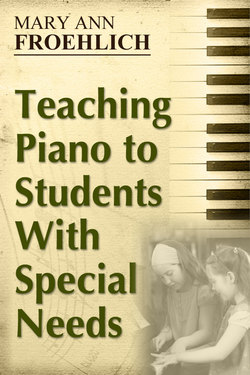Читать книгу Teaching Piano to Students With Special Needs - Mary Ann Froehlich - Страница 6
На сайте Литреса книга снята с продажи.
Bridging the Hemispheres
ОглавлениеMany years of intensive deliberate practice actually change the body and the brain.
Geoff Colvin
Neurons are the information carriers of the brain. Daniel Levitin explains that the average brain has one hundred billion neurons, each neuron connecting to another one in limitless combinations. The potential of the brain comes from these interconnections. In This Is Your Brain on Music, Levitin describes the brain as a parallel processing machine, not a serial processor. When we are making music, every region in our working brain is affected as some point in the process, often at the same moment.
In Arts with the Brain in Mind, Eric Jensen states that music making may be a fast track to engaging and enhancing higher brain activities. He explains:
Music helps you think by activating and synchronizing neural firing patterns that orchestrate and connect multiple brain sites. The neural synchrony ensembles increase both the brain’s efficiency and effectiveness. These key systems are well connected and located in the frontal, parietal, and temporal lobes, as well as the cerebellum.1
The corpus callosum, the bridge connecting the two cerebral hemispheres, has been discovered to be thicker in musicians than non-musicians, most notably enlarged in musicians who began training as young children. The corpus callosum completes its development by age 11. The cerebellum, the region of the brain involved in rhythm and coordination, has also been found to be larger in musicians.
More recent research, due to new brain scan imaging, reveals that white matter in the brain is more developed in musicians, specifically pianists, than non-musicians. White matter, as in the corpus callosum, consists of the cables which connect the neurons, the gray matter of the brain. These cables are coated in myelin, which continues to develop into adulthood. Neuroplasticity is the ability of the brain to make new connections and reorganize itself as it receives sensory input or adapts to changes in the body. This occurs at an explosive rate in childhood and slows as we age.
Learning a complex skill requiring hours of repeated practice, such as playing an instrument or practicing a sport, changes the white matter in the brain. It establishes neural pathways, laying down tracks. Myelin creates neural freeways, developing muscle memory. Children’s brains are still myelinating which is why it is much easier for them to learn to play an instrument, develop an athletic ability, become fluent in a foreign language, or achieve expertise in many pursuits. Adults can and should certainly learn new skills but the optimum window of opportunity has passed. These abilities will never be as natural for them as they are for adults who learned these skills as young children. Professional concertizing musicians and world class athletes were not first exposed to those skills as young adults. Frank Wilson calls musicians “small muscle athletes” and views learning to play an instrument as the ultimate integration of our neurological and motor systems. You may already be familiar with the well-known“10 Years or 10,000 Hours Rule.” Practicing a skill with intense focus for ten years or 10,000 hours appears to be the formula for honing an expert skill. The experience of daily focused practice is more important than natural ability or intelligence.
